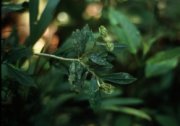 |
QUICK SEARCH
MO PROJECTS:
Africa
Asia/Pacific
Mesoamerica
North America
South America
General Taxonomy
Photo Essays
Training in Latin
America
MO RESEARCH:
Wm. L. Brown Center
Bryology
GIS
Graduate Studies
Research Experiences
for Undergraduates
Imaging Lab
Library
MBG Press
Publications
Climate Change
Catalog Fossil Plants
MO DATABASES:
W³MOST
Image Index
Rare Books
Angiosperm
Phylogeny
Res Botanica
All Databases
INFORMATION:
What's New?
People at MO
Visitor's Guide
Herbarium
Jobs & Fellowships
Symposium
Research Links
Site Map
Search
Didymochlamys Hook.f. (Rubiaceae: not assigned to subfamily or tribe)Charlotte M. Taylor [webpage]
The inflorescences of Didymochlamys are distinctive, with a short fascicle of 2-5 flowers enclosed in two complanate enlarged green bracts (the genus name refers to these bracts). The relatively small flowers are white often tinged with blue or violet, and their lobes have the margins crisped to incised or appendaged. The cupuliform fruits are berrylike at least in their early stages, although those of D. connellii are reportedly later dehiscent though at the apex (whether this dehiscence is loculicidal or septicidal is unreported). The numerous seeds are small and bear a tuft of silky trichomes at one end, similarly to the seeds of Hillia Jacq. The relationships of Didymochlamys within the Rubiaceae are not yet clear, and this genus has never been studied in any detail. Steyermark (1967) did review this genus, but quite briefly. Steyermark (1974) presented a floristic treatment for D. connellii in Venezuela and an illustration [1974(1): p. 428, fig. 70]. Dwyer (1980) presented a floristic treatment of D. whitei in Panama and illustration (1980: p. 148, fig. 33), but incorrectly called the Panamanian plants "D. connellii". Key to the Species of Didymochlamys
References
List of Names and Synonyms of Hillia Further information on these names can be found in the TROPICOS database [http://www.tropicos.org/]. Didymochlamys connellii N.E. Brown, southeastern Venezuela
to Guyana, Didymochlamys whitei Hook.f., southern Nicaragua to western Colombia,
Text and Images, unless otherwise indicated, Copyright © by Charlotte M. Taylor. All rights reserved.
This page was revised on April 8, 2008.
|
||||||
© 1995-2024 Missouri Botanical Garden, All Rights Reserved
4344 Shaw Blvd.
St. Louis, MO 63110
(314) 577-5100
Technical Support

